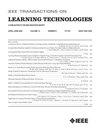The Impact of Embedding Interactive Tasks in Augmented Reality Storybooks on Children's Reading Engagement and Reading Comprehension
IF 2.9
3区 教育学
Q2 COMPUTER SCIENCE, INTERDISCIPLINARY APPLICATIONS
引用次数: 0
Abstract
In early education, reading difficulties can lead to negative outcomes. Augmented reality (AR) storybooks combine the benefits of e-books and print books, significantly aiding children's reading skills and gaining recognition from scholars and educators. However, the existing AR storybooks often overlook the design of interactive features, which may explain the inconsistent findings in research on their impact. This study aims to embed interactive tasks into AR storybooks and investigate their effects on children's reading engagement, story retelling, and reading comprehension. In total, 40 children aged eight to ten years were invited to participate in the reading activity. They were randomly assigned to an experimental group and a control group. The experimental group used AR storybooks that included interactive tasks, requiring them to complete various activities during reading. The control group used AR storybooks without interactive tasks, which provided multisensory experiences. Throughout the activity, researchers observed each child's reading engagement and completed a reading engagement assessment form. At the end of the activity, all children completed story retelling and reading comprehension tests. Finally, both groups of children participated in semistructured interviews for cross validation. The study found that children in the experimental group showed significantly higher levels of reading engagement, story retelling, and reading comprehension than children in the control group. While multimedia elements in AR storybooks can increase children's reading engagement, a large part of that engagement is driven by children's focus on AR elements. However, interactive tasks shift children's engagement more toward the story content. We also discovered that interactive tasks are a key factor in encouraging children to think actively and serve as an effective strategy for guiding them to focus on the main issues in the story. In addition, the strategy search decision feedback within the interactive tasks greatly aids children in understanding and remembering the story.增强现实故事书中嵌入互动任务对儿童阅读投入和阅读理解的影响
在早期教育中,阅读困难可能会导致负面结果。增强现实(AR)故事书结合了电子书和纸质书的优点,极大地帮助了儿童的阅读技能,并获得了学者和教育工作者的认可。然而,现有的AR故事书往往忽略了交互功能的设计,这可能解释了其影响研究结果不一致的原因。本研究旨在将互动任务嵌入AR故事书中,并探讨其对儿童阅读参与、故事复述和阅读理解的影响。总共有40名8到10岁的孩子被邀请参加了这次阅读活动。他们被随机分为实验组和对照组。实验组使用包含互动任务的AR故事书,要求他们在阅读过程中完成各种活动。对照组使用没有互动任务的AR故事书,提供多感官体验。在整个活动过程中,研究人员观察了每个孩子的阅读参与情况,并完成了一份阅读参与评估表格。活动结束后,所有孩子都完成了故事复述和阅读理解测试。最后,两组儿童都参加了半结构化访谈以进行交叉验证。研究发现,实验组的孩子在阅读投入、故事复述和阅读理解方面的水平明显高于对照组的孩子。虽然AR故事书中的多媒体元素可以提高儿童的阅读参与度,但这种参与度很大程度上是由儿童对AR元素的关注驱动的。然而,互动任务将孩子们的注意力更多地转移到故事内容上。我们还发现,互动任务是鼓励孩子积极思考的关键因素,也是引导他们关注故事主要问题的有效策略。此外,互动任务中的策略搜索决策反馈对儿童理解和记忆故事有很大的帮助。
本文章由计算机程序翻译,如有差异,请以英文原文为准。
求助全文
约1分钟内获得全文
求助全文
来源期刊

IEEE Transactions on Learning Technologies
COMPUTER SCIENCE, INTERDISCIPLINARY APPLICATIONS-
CiteScore
7.50
自引率
5.40%
发文量
82
审稿时长
>12 weeks
期刊介绍:
The IEEE Transactions on Learning Technologies covers all advances in learning technologies and their applications, including but not limited to the following topics: innovative online learning systems; intelligent tutors; educational games; simulation systems for education and training; collaborative learning tools; learning with mobile devices; wearable devices and interfaces for learning; personalized and adaptive learning systems; tools for formative and summative assessment; tools for learning analytics and educational data mining; ontologies for learning systems; standards and web services that support learning; authoring tools for learning materials; computer support for peer tutoring; learning via computer-mediated inquiry, field, and lab work; social learning techniques; social networks and infrastructures for learning and knowledge sharing; and creation and management of learning objects.
 求助内容:
求助内容: 应助结果提醒方式:
应助结果提醒方式:


